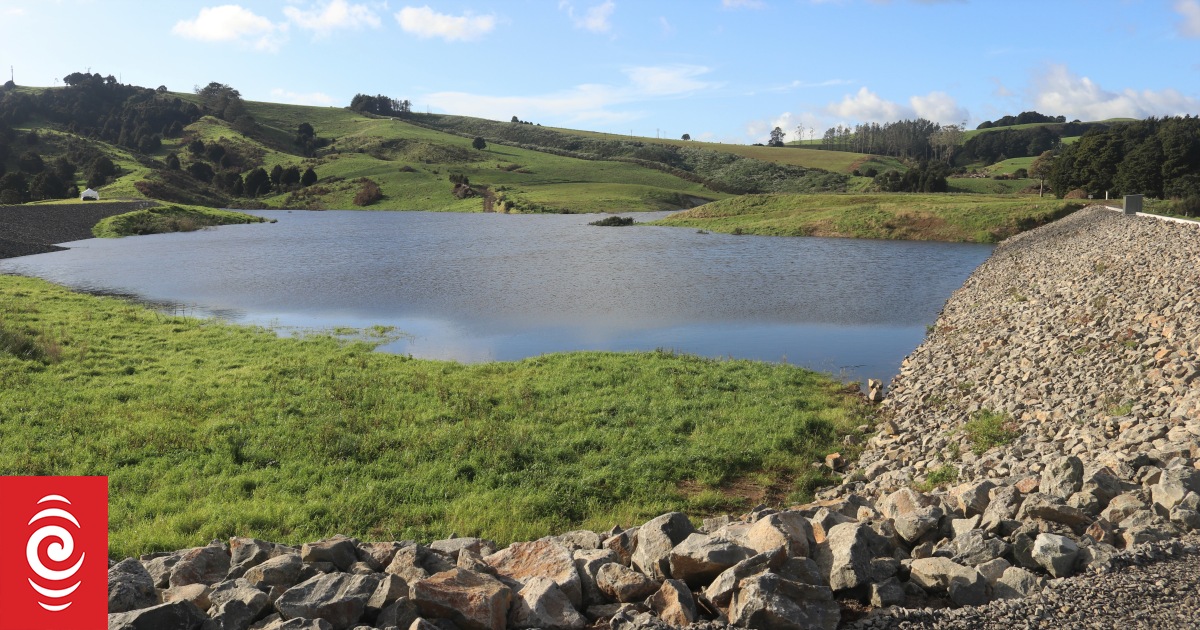
Regional Development Minister Shane Jones says the Matawii irrigation dam, built near Kaikohe with a PGF loan, is an example of how government funding can transform regional economies.
Photo: RNZ / Peter de Graaf
A dry dock, projects to stave off droughts and floods, and better transmission for the Far North’s abundant renewable power could be on the wish list at a summit discussing Northland’s share of the $1.2 billion Regional Infrastructure Fund.
Friday’s summit, at Ngāwhā, near Kaikohe, aims to bring the region’s movers and shakers together with Regional Development Minister Shane Jones.
Business leaders, industry, iwi and local government have all been invited to the fourth of 15 such summits around the motu.
Jones said the three-year, $1.2 billion Regional Infrastructure Fund was one of the conditions of the National-New Zealand First coalition agreement.
No specific sum had been set aside for Northland.
He wanted Northlanders to identify the priorities themselves, but he expected the list would include a dry dock at Marsden Point for ship maintenance.
That was likely to cost more than $500 million and require a mix of private and public capital.
Another possibility was the $160-170 million required to boost power transmission capacity from the Far North to Whangārei, in order to supply growing demand in Auckland.

Matawii Dam, built near Kaikohe with a PGF loan, is opened in 2023 by then-Regional Development Minister Kiri Allan and Te Tai Tokerau Water trustees Dover Samuels and Murray McCully.
Photo: RNZ / Peter de Graaf
The Far North had great potential as an exporter of renewable geothermal and solar energy, but the power lines from there to Marsden Point were already at capacity, limiting future growth.
Land conversion, marina developments, and ongoing flood protection work were other options that had been raised, Jones said.
Elsewhere in New Zealand, such as Wairarapa, there had been a great deal of interest in the irrigation dams built in Northland using loans from the Provincial Growth Fund, the Regional Infrastructure Fund’s predecessor.
Water storage would become increasing important in the face of changing weather patterns, Jones said.
Other standouts from the PGF, a condition of the 2017-2020 Labour-New Zealand First coalition agreement, included Bay of Islands Airport at Kerikeri and “overdue” roundabouts at Puketona, Kawakawa and Waipapa.
“And who cannot be moved by the pūtea [money] that went into the Māori Battalion Museum at Waitangi?”

Regional Development Minister Shane Jones names the upgraded Bay of Islands Airport in Kerikeri as one of the standout achievements of the Provincial Growth Fund in Northland.
Photo: Supplied
Jones rejected accusations made at the time that the PGF was a vote-buying slush fund.
“That kind of rhetoric is always going to surround a voluble politician such as myself.
But I think that the proof is evident every single hour of the day. It’s important infrastructure.”
The stated aim of the RIF is to deliver “on the Government’s promise to address the regional infrastructure deficit” and “help boost the New Zealand economy, increase regional prosperity, and create jobs”.
It will provide funding through a mix of loans and equity investments, with grants available only in rare cases.
The fund will be administered by Kānoa Regional Economic Development and Investment Unit, the same agency that administers projects started under the PGF and the later Covid-19 Response and Recovery Fund.
To be eligible for RIF funding, projects must be focussed on “hard infrastructure”, contribute to regional resilience or productivity, and be based in the provinces. Auckland, Wellington and Christchurch are specifically excluded.
The summit starts at 2pm at Ngāwhā Innovation Park, off State Highway 12.




